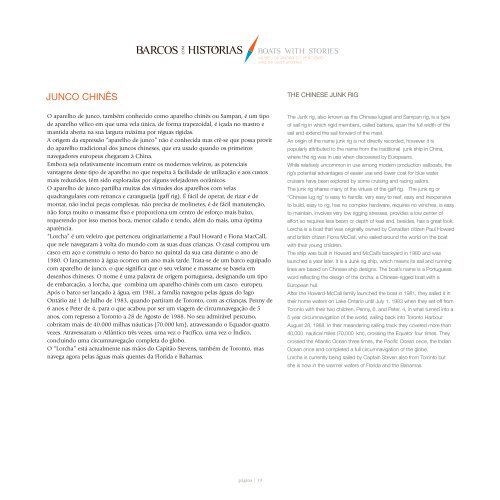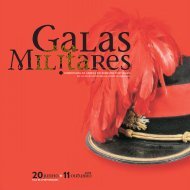Versão digital - Museu de Angra do Heroísmo
Versão digital - Museu de Angra do Heroísmo
Versão digital - Museu de Angra do Heroísmo
You also want an ePaper? Increase the reach of your titles
YUMPU automatically turns print PDFs into web optimized ePapers that Google loves.
JUNCO CHINÊS<br />
O aparelho <strong>de</strong> junco, também conheci<strong>do</strong> como aparelho chinês ou Sampan, é um tipo<br />
<strong>de</strong> aparelho vélico em que uma vela única, <strong>de</strong> forma trapezoidal, é içada no mastro e<br />
mantida aberta na sua largura máxima por réguas rígidas.<br />
A origem da expressão “aparelho <strong>de</strong> junco” não é conhecida mas crê-se que possa provir<br />
<strong>do</strong> aparelho tradicional <strong>do</strong>s juncos chineses, que era usa<strong>do</strong> quan<strong>do</strong> os primeiros<br />
navega<strong>do</strong>res europeus chegaram à China.<br />
Embora seja relativamente incomum entre os mo<strong>de</strong>rnos veleiros, as potenciais<br />
vantagens <strong>de</strong>ste tipo <strong>de</strong> aparelho no que respeita à facilida<strong>de</strong> <strong>de</strong> utilização e aos custos<br />
mais reduzi<strong>do</strong>s, têm si<strong>do</strong> exploradas por alguns veleja<strong>do</strong>res oceânicos.<br />
O aparelho <strong>de</strong> junco partilha muitas das virtu<strong>de</strong>s <strong>do</strong>s aparelhos com velas<br />
quadrangulares com retranca e carangueija (gaff rig). É fácil <strong>de</strong> operar, <strong>de</strong> rizar e <strong>de</strong><br />
montar, não inclui peças complexas, não precisa <strong>de</strong> molinetes, é <strong>de</strong> fácil manutenção,<br />
não força muito o massame fixo e proporciona um centro <strong>de</strong> esforço mais baixo,<br />
requeren<strong>do</strong> por isso menos boca, menor cala<strong>do</strong> e ten<strong>do</strong>, além <strong>do</strong> mais, uma óptima<br />
aparência.<br />
“Lorcha” é um veleiro que pertenceu originariamente a Paul Howard e Fiona MacCall,<br />
que nele navegaram à volta <strong>do</strong> mun<strong>do</strong> com as suas duas crianças. O casal comprou um<br />
casco em aço e construiu o resto <strong>do</strong> barco no quintal da sua casa durante o ano <strong>de</strong><br />
1980. O lançamento à água ocorreu um ano mais tar<strong>de</strong>. Trata-se <strong>de</strong> um barco equipa<strong>do</strong><br />
com aparelho <strong>de</strong> junco, o que significa que o seu velame e massame se baseia em<br />
<strong>de</strong>senhos chineses. O nome é uma palavra <strong>de</strong> origem portuguesa, <strong>de</strong>signan<strong>do</strong> um tipo<br />
<strong>de</strong> embarcação, a lorcha, que combina um aparelho chinês com um casco europeu.<br />
Após o barco ser lança<strong>do</strong> à água, em 1981, a família navegou pelas águas <strong>do</strong> lago<br />
Ontário até 1 <strong>de</strong> Julho <strong>de</strong> 1983, quan<strong>do</strong> partiram <strong>de</strong> Toronto, com as crianças, Penny <strong>de</strong><br />
6 anos e Peter <strong>de</strong> 4, para o que acabou por ser um viagem <strong>de</strong> circumnavegação <strong>de</strong> 5<br />
anos, com regresso a Toronto a 28 <strong>de</strong> Agosto <strong>de</strong> 1988. No seu admirável percurso,<br />
cobriram mais <strong>de</strong> 40.000 milhas náuticas (70.000 km), atravessan<strong>do</strong> o Equa<strong>do</strong>r quatro<br />
vezes. Atravessaram o Atlântico três vezes, uma vez o Pacífico, uma vez o Índico,<br />
concluin<strong>do</strong> uma circumnavegação completa <strong>do</strong> globo.<br />
O “Lorcha” está actualmente nas mãos <strong>do</strong> Capitão Stevens, também <strong>de</strong> Toronto, mas<br />
navega agora pelas águas mais quentes da Florida e Bahamas.<br />
página | 19<br />
THE CHINESE JUNK RIG<br />
The Junk rig, also known as the Chinese lugsail and Sampan rig, is a type<br />
of sail rig in which rigid members, called battens, span the full width of the<br />
sail and extend the sail forward of the mast.<br />
An origin of the name junk rig is not directly recor<strong>de</strong>d, however it is<br />
popularly attributed to the name from the traditional junk ship in China,<br />
where the rig was in use when discovered by Europeans.<br />
While relatively uncommon in use among mo<strong>de</strong>rn production sailboats, the<br />
rig’s potential advantages of easier use and lower cost for blue water<br />
cruisers have been explored by some cruising and racing sailors.<br />
The junk rig shares many of the virtues of the gaff rig. The junk rig or<br />
“Chinese lug rig” is easy to handle, very easy to reef, easy and inexpensive<br />
to build, easy to rig, has no complex hardware, requires no winches, is easy<br />
to maintain, involves very low rigging stresses, provi<strong>de</strong>s a low center of<br />
effort so requires less beam or <strong>de</strong>pth of keel and, besi<strong>de</strong>s, has a great look.<br />
Lorcha is a boat that was originally owned by Canadian citizen Paul Howard<br />
and british citizen Fiona McCall, who sailed around the world on the boat<br />
with their young children.<br />
The ship was built in Howard and McCall’s backyard in 1980 and was<br />
launched a year later. It is a Junk rig ship, which means its sail and running<br />
lines are based on Chinese ship <strong>de</strong>signs. The boat’s name is a Portuguese<br />
word reflecting the <strong>de</strong>sign of the lorcha: a Chinese-rigged boat with a<br />
European hull.<br />
After the Howard-McCall family launched the boat in 1981, they sailed it in<br />
their home waters on Lake Ontario until July 1, 1983 when they set off from<br />
Toronto with their two children, Penny, 6, and Peter, 4, in what turned into a<br />
5 year circumnavigation of the world, sailing back into Toronto Harbour<br />
August 28, 1988. In their mean<strong>de</strong>ring sailing track they covered more than<br />
40,000 nautical miles (70,000 km), crossing the Equator four times. They<br />
crossed the Atlantic Ocean three times, the Pacific Ocean once, the Indian<br />
Ocean once and completed a full circumnavigation of the globe.<br />
Lorcha is currently being sailed by Captain Steven also from Toronto but<br />
she is now in the warmer waters of Florida and the Bahamas.



